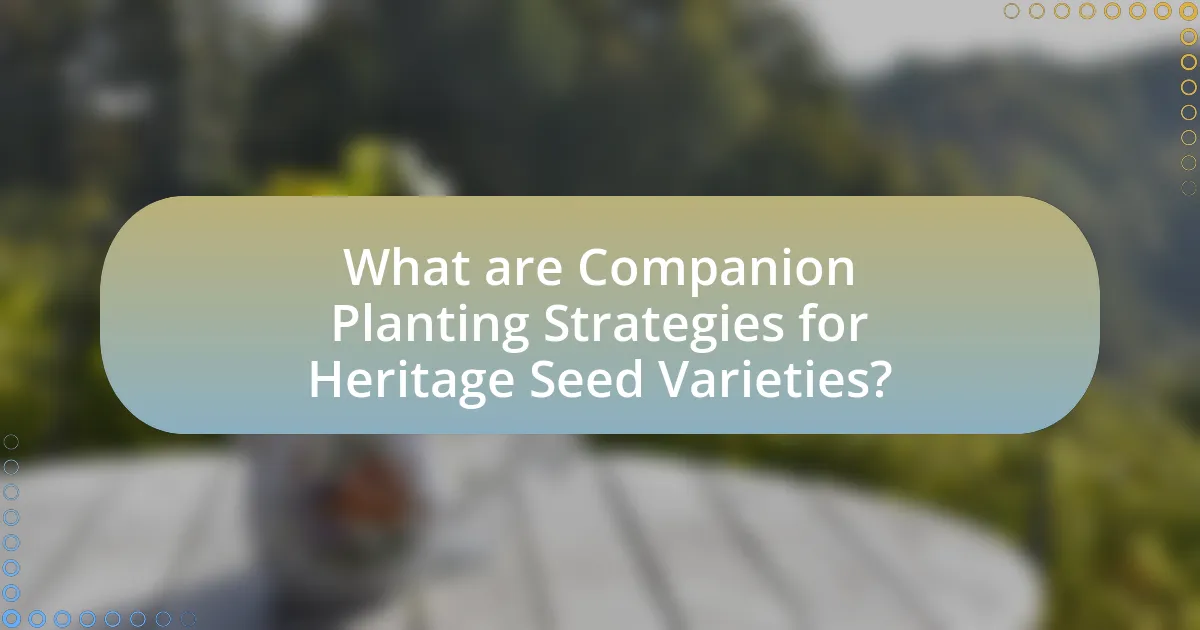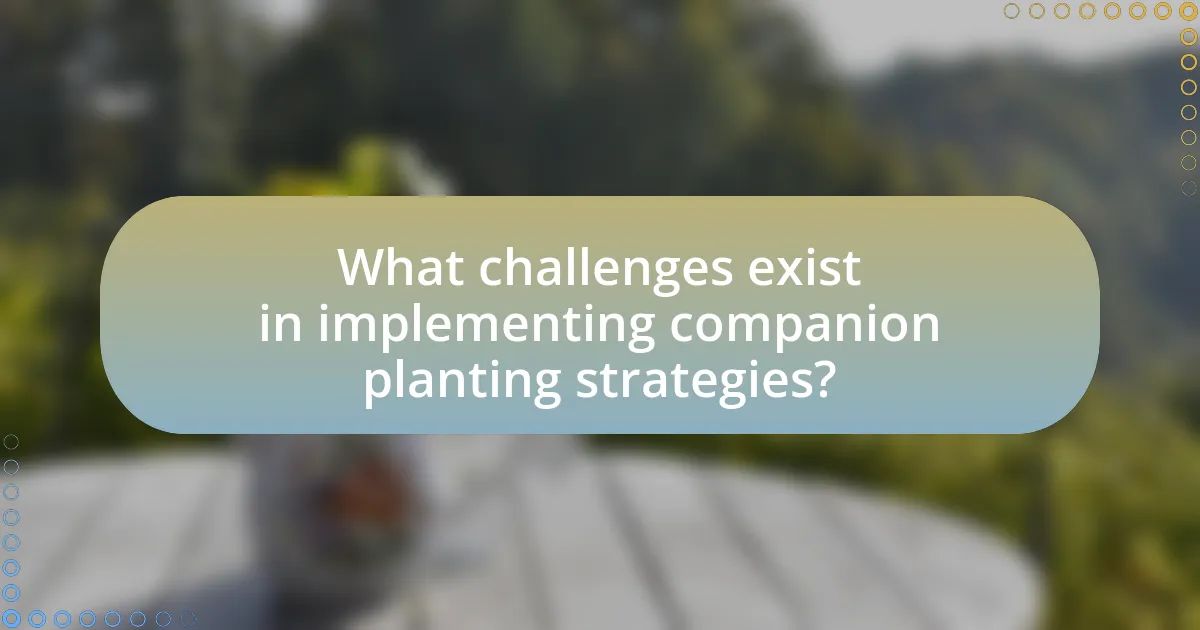Companion planting strategies for heritage seed varieties involve pairing compatible plants to enhance growth, deter pests, and improve yields. These strategies benefit heritage seeds by increasing biodiversity, improving soil health, and providing natural pest management, which is crucial for maintaining the integrity of these varieties. The article explores specific advantages of companion planting, such as enhanced pest control and nutrient availability, as well as common plant pairings and the principles guiding successful implementation. Additionally, it addresses challenges in companion planting and offers practical tips for optimizing these strategies in sustainable agriculture.

What are Companion Planting Strategies for Heritage Seed Varieties?
Companion planting strategies for heritage seed varieties involve pairing compatible plants to enhance growth, deter pests, and improve yields. For example, planting beans alongside corn allows beans to fix nitrogen in the soil, benefiting the corn, while marigolds can be interplanted to repel nematodes and other pests. Research indicates that these strategies can lead to healthier plants and increased biodiversity in the garden, which is particularly beneficial for maintaining the integrity of heritage seed varieties that may be more susceptible to disease and pests.
How do companion planting strategies benefit heritage seed varieties?
Companion planting strategies benefit heritage seed varieties by enhancing biodiversity and improving soil health. These strategies involve planting compatible species together, which can lead to increased pest resistance and better pollination. For instance, planting marigolds alongside tomatoes can deter nematodes, thereby protecting the heritage tomato varieties. Additionally, companion planting can improve nutrient uptake; for example, legumes fix nitrogen in the soil, benefiting nearby heritage crops that require nitrogen-rich conditions. Research indicates that diverse planting systems can lead to higher yields and resilience against diseases, supporting the sustainability of heritage seed varieties in agricultural practices.
What specific advantages do heritage seed varieties gain from companion planting?
Heritage seed varieties gain several specific advantages from companion planting, including enhanced pest control, improved pollination, and increased nutrient availability. Companion planting allows heritage varieties to thrive by deterring pests through natural repellents produced by companion plants, which can reduce the need for chemical pesticides. Additionally, certain companion plants attract beneficial insects that aid in pollination, leading to better fruit and seed production for heritage varieties. Furthermore, companion plants can enhance soil fertility by fixing nitrogen or improving soil structure, which benefits the nutrient uptake of heritage seeds. These advantages are supported by studies showing that diverse plantings can lead to higher yields and healthier crops, as evidenced by research conducted by the University of California, which highlights the positive impacts of companion planting on crop resilience and productivity.
How does companion planting enhance biodiversity in heritage seed cultivation?
Companion planting enhances biodiversity in heritage seed cultivation by promoting a diverse ecosystem that supports various plant species and beneficial organisms. This method encourages the growth of complementary plants that can improve soil health, attract pollinators, and deter pests, thereby creating a more resilient agricultural environment. For instance, planting legumes alongside heritage crops can fix nitrogen in the soil, benefiting neighboring plants and increasing overall biodiversity. Studies have shown that diverse plantings can lead to higher yields and improved pest management, as seen in research conducted by the University of California, which found that intercropping can reduce pest populations by up to 50%.
Why is companion planting important for sustainable agriculture?
Companion planting is important for sustainable agriculture because it enhances biodiversity, improves pest management, and increases crop yields. By strategically planting compatible species together, farmers can create a more resilient ecosystem that naturally deters pests and diseases. For instance, the combination of marigolds with vegetables can repel nematodes and other harmful insects, reducing the need for chemical pesticides. Additionally, studies have shown that companion planting can lead to improved nutrient uptake and soil health, as seen in the practice of intercropping legumes with cereals, which enhances nitrogen fixation. This method not only supports sustainable farming practices but also contributes to the overall health of the agricultural environment.
How does companion planting contribute to soil health?
Companion planting contributes to soil health by enhancing nutrient availability and promoting beneficial microbial activity. Certain plant combinations can fix nitrogen in the soil, such as legumes, which enrich the soil for neighboring plants. Additionally, diverse root structures from companion plants can improve soil aeration and water retention, leading to healthier soil ecosystems. Research indicates that companion planting can increase soil organic matter and microbial diversity, which are critical for maintaining soil fertility and structure.
What role does companion planting play in pest management?
Companion planting plays a significant role in pest management by utilizing specific plant combinations to deter pests and enhance plant health. Certain plants can repel harmful insects, attract beneficial predators, or create a habitat that disrupts pest life cycles. For example, marigolds are known to repel nematodes and aphids, while basil can deter flies and mosquitoes. Research has shown that these interactions can lead to reduced pest populations and lower reliance on chemical pesticides, promoting a more sustainable agricultural practice.

What are the key principles of companion planting?
The key principles of companion planting include enhancing growth, repelling pests, attracting beneficial insects, and improving soil health. These principles are based on the idea that certain plants can benefit each other when grown together. For example, planting marigolds alongside vegetables can deter nematodes and other pests, while legumes can fix nitrogen in the soil, benefiting neighboring plants. Research has shown that companion planting can lead to increased yields and reduced need for chemical fertilizers and pesticides, supporting sustainable agricultural practices.
How can plant compatibility be determined for heritage seed varieties?
Plant compatibility for heritage seed varieties can be determined through several methods, including understanding plant families, growth habits, and nutrient requirements. Research indicates that plants within the same family often share similar pest and disease vulnerabilities, which can affect compatibility. Additionally, observing the growth habits, such as height and spread, helps ensure that plants do not compete for light and space. Nutrient requirements also play a crucial role; for instance, some plants may deplete soil nutrients that others need, leading to poor growth. Historical gardening practices and studies, such as those documented in “The Garden Primer” by Barbara Damrosch, provide insights into successful pairings and combinations that enhance growth and yield.
What factors should be considered when selecting companion plants?
When selecting companion plants, factors such as plant compatibility, growth habits, nutrient requirements, pest and disease resistance, and environmental conditions should be considered. Plant compatibility ensures that the chosen species can coexist without hindering each other’s growth; for example, legumes can fix nitrogen in the soil, benefiting neighboring plants. Growth habits, including height and spread, influence light availability and space utilization. Nutrient requirements must align to prevent competition for resources, while pest and disease resistance can enhance overall garden health by deterring harmful insects. Lastly, environmental conditions like soil type, moisture levels, and sunlight exposure are crucial for the successful growth of both companion plants.
How do growth habits and nutrient needs influence plant pairings?
Growth habits and nutrient needs significantly influence plant pairings by determining compatibility in resource utilization and spatial requirements. For instance, plants with deep root systems, like carrots, can thrive alongside shallow-rooted plants, such as lettuce, as they occupy different soil layers and reduce competition for nutrients. Additionally, nutrient needs play a crucial role; legumes, which fix nitrogen in the soil, can enhance the growth of nitrogen-demanding plants like corn when paired together. This symbiotic relationship optimizes nutrient availability and promotes healthier growth, demonstrating that understanding these factors is essential for effective companion planting strategies.
What are some common companion planting combinations for heritage seeds?
Common companion planting combinations for heritage seeds include tomatoes with basil, which enhances flavor and repels pests; corn with beans and squash, known as the Three Sisters, which supports growth and maximizes space; and carrots with onions, where onions deter carrot flies. These combinations are based on historical agricultural practices that demonstrate improved yields and pest management. For instance, the Three Sisters method has been used by Indigenous peoples for centuries, showcasing its effectiveness in sustainable farming.
Which plants are best companions for tomatoes among heritage varieties?
Basil and marigold are the best companion plants for tomatoes among heritage varieties. Basil enhances the flavor of tomatoes and can repel pests such as aphids and whiteflies. Marigolds, particularly French marigolds, deter nematodes and other harmful insects, promoting healthier tomato plants. Studies have shown that these companion plants can improve growth and yield, making them effective choices for gardeners utilizing heritage tomato varieties.
How do beans and corn work together in companion planting?
Beans and corn work together in companion planting through a symbiotic relationship known as the “Three Sisters” method, where beans provide nitrogen to the soil, benefiting corn, while corn offers support for the climbing bean plants. This relationship enhances soil fertility and maximizes space, as the beans fix atmospheric nitrogen, enriching the soil for the corn, which requires higher nitrogen levels for optimal growth. Historical evidence from Native American agricultural practices demonstrates that this method not only improves crop yields but also promotes biodiversity and pest resistance in the garden ecosystem.

What challenges exist in implementing companion planting strategies?
Implementing companion planting strategies faces several challenges, including the complexity of plant interactions, the need for extensive knowledge about specific plant pairings, and potential pest and disease issues. The complexity arises because not all plants benefit from being grown together; some may compete for resources or inhibit each other’s growth. Additionally, successful companion planting requires gardeners to have a deep understanding of the specific needs and characteristics of heritage seed varieties, which can vary significantly. Furthermore, pests and diseases may still affect companion plants, complicating the management of crop health. These challenges necessitate careful planning and ongoing observation to ensure effective implementation of companion planting strategies.
How can gardeners overcome common obstacles in companion planting?
Gardeners can overcome common obstacles in companion planting by selecting compatible plant pairings based on their growth habits, nutrient needs, and pest resistance. For instance, planting marigolds alongside vegetables can deter pests, while legumes can enhance soil nitrogen levels for neighboring plants. Research indicates that specific combinations, such as tomatoes with basil, not only improve flavor but also repel harmful insects. By understanding these relationships and utilizing resources like companion planting charts, gardeners can effectively navigate challenges such as pest management and nutrient deficiencies, leading to healthier crops and improved yields.
What are the potential pitfalls of poor plant pairings?
Poor plant pairings can lead to reduced growth, increased pest infestations, and nutrient competition. When incompatible plants are grown together, they may inhibit each other’s growth through allelopathy, where one plant releases chemicals that negatively affect another. Additionally, poor pairings can attract pests that thrive on specific plants, leading to infestations that could have been avoided with better choices. For example, planting tomatoes near corn can result in increased susceptibility to pests like the corn earworm, which may not affect tomatoes alone. Furthermore, plants with similar nutrient requirements can compete for resources, leading to stunted growth and lower yields.
How can environmental factors affect companion planting success?
Environmental factors significantly influence companion planting success by affecting plant growth, nutrient availability, and pest interactions. For instance, soil quality determines nutrient levels and moisture retention, which are crucial for the health of both companion plants. Additionally, light exposure impacts photosynthesis; plants that require full sun may struggle when shaded by taller companions. Temperature variations can also affect germination rates and growth cycles, leading to mismatched planting schedules. Furthermore, humidity levels can influence pest populations; higher humidity may promote fungal diseases that can harm companion plants. Studies have shown that optimizing these environmental conditions can enhance the benefits of companion planting, such as improved pest resistance and increased yields.
What resources are available for learning more about companion planting?
Books, online courses, and gardening websites are valuable resources for learning about companion planting. Notable books include “Carrots Love Tomatoes” by Louise Riotte, which provides insights into beneficial plant pairings, and “The Vegetable Gardener’s Bible” by Edward C. Smith, which covers various gardening techniques including companion planting. Online platforms like the National Gardening Association offer articles and guides on the subject, while courses on websites such as Udemy and Coursera provide structured learning experiences. These resources are widely recognized for their practical advice and research-backed information on companion planting strategies.
Where can one find guides and literature on heritage seed varieties and companion planting?
Guides and literature on heritage seed varieties and companion planting can be found through various reputable sources such as agricultural extension services, university agricultural departments, and specialized gardening organizations. For instance, the Seed Savers Exchange offers extensive resources on heritage seeds, while the University of California’s Agriculture and Natural Resources provides research-based information on companion planting strategies. Additionally, books like “The Companion Planting Handbook” by Michael MacCaskey and “Seed to Seed” by Suzanne Ashworth serve as valuable references for both topics. These sources are recognized for their accuracy and depth of information in the field of gardening and agriculture.
What online communities or forums discuss companion planting strategies?
Online communities and forums that discuss companion planting strategies include the Permies forum, which focuses on permaculture and sustainable gardening practices, and the GardenWeb forums, where users share experiences and advice on various gardening topics, including companion planting. Additionally, Reddit hosts several subreddits such as r/gardening and r/companionplanting, where members exchange tips and strategies related to companion planting. These platforms provide a wealth of information and community support for gardeners interested in optimizing their planting strategies.
What practical tips can enhance companion planting success with heritage seed varieties?
To enhance companion planting success with heritage seed varieties, select compatible plants that benefit each other, such as pairing legumes with nitrogen-fixing plants. This strategy improves soil fertility and promotes healthy growth. Additionally, planting heritage varieties that are well-adapted to local conditions increases resilience against pests and diseases, as these varieties often have natural defenses. Research indicates that diverse plantings can reduce pest populations and improve yields; for example, a study published in the journal “Agriculture, Ecosystems & Environment” found that intercropping can lead to a 20-30% increase in crop productivity. Implementing these practices can significantly improve the effectiveness of companion planting with heritage seeds.





